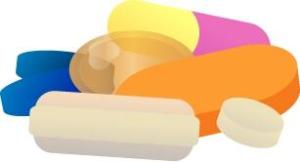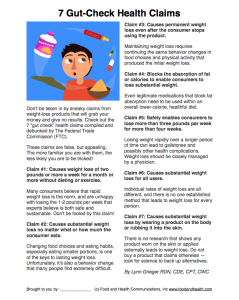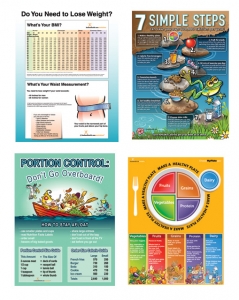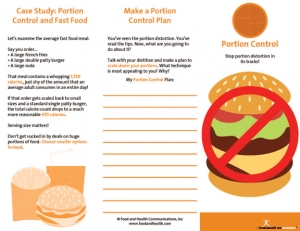 “Fast, easy weight loss without exercise!”
“Fast, easy weight loss without exercise!”
“Lose weight while you sleep.”
“Enjoy your favorite foods and lose weight. Effortlessly.”
These claims have to be true because I : (a) read it in my local newspaper, (b) saw it online, (c) heard it on my favorite radio station.
Right?
Wrong!
We know better, but wouldn’t it be great if there really was a product that produced these types of results?
The Federal Trade Commission (FTC), the nation’s consumer protection agency, published “Gut Check: A Reference Guide for Media on Spotting False Weight-Loss Claims” in January 2014. This guide lists seven weight loss claims that experts agree are false and misleading, and which should prompt a “gut check.”
What’s a gut check? It’s a second look to make sure that publishers are not running advertisements with claims that are known to be false.
The FTC uses these guidelines to enlist the help of media professionals, asking them to prevent false claims from ever appearing. Even though the truth in advertising laws prohibit false or misleading advertising claims, obviously these claims still exist. Under the law, advertisers have two choices: either the results in the ad must be typical of what other consumers can expect to achieve or the ad must clearly and conspicuously disclose the typical results.
The FTC created a teaser website http://www.wemarket4u.net/fatfoe/index.html that promotes FatFoe™, a revolutionary (and fake) product that produces amazing weight loss results. They built this website to demonstrate false advertising claims to consumers. Click on the ‘order now’ button and you are transferred to a site that explains how you’ve been duped and how to spot false weight loss claims.
So. How can you best put this information to use for your clients? Have them use the seven gut-check claims and examples of the fictitious yet all-too-believable FatFoe™ advertisements to avoid falling prey to wild and unrealistic claims. Here are a few examples — the more familiar your clients are with these compelling (yet false!) claims, the less likely they are to be duped by a sneaky product…
 Claim #1: Causes weight loss of two pounds or more a week for a month or more without dieting or exercise.
Claim #1: Causes weight loss of two pounds or more a week for a month or more without dieting or exercise.
Many consumers believe that rapid weight loss is the norm, and are unhappy with losing the 1-2 pounds per week that experts believe is both safe and sustainable.
“Finally there’s FatFoe™, an all-natural weight loss compound so powerful, so effective, so relentless in its awesome attack on bulging fatty deposits that it eliminates the need to diet.” (Note the consumer endorsement: “I lost 36 pounds in 5 short weeks”).
Remember, don’t be fooled.
Claim #2: Causes substantial weight loss no matter what or how much the consumer eats.
Changing food choices and eating habits, especially eating smaller portions, is one of the keys to lasting weight loss. Unfortunately, it’s also a behavior change that many people find extremely difficult.
Watch out for claims like, “This revolutionary product lets you enjoy all your favorites – hamburgers, fries, pasta, sausage, and even gooey desserts – and still lose weight. One FatFoe™ tablet before meals does the work for you and you’ll lose all the weight you want.”
Claim #3: Causes permanent weight loss even after the consumer stops using the product.
Maintaining weight loss requires continuing the same behavior changes in food choices and physical activity that produced the initial weight loss.
How does this false claim get used? “Thousands of people have used FatFoe™ and kept the weight off for good” is just one example.
 Claim #4: Blocks the absorption of fat or calories to enable consumers to lose substantial weight.
Claim #4: Blocks the absorption of fat or calories to enable consumers to lose substantial weight.
Even legitimate medications that block fat absorption need to be used within an overall lower-calorie, healthful diet.
“The safe, all-natural active ingredient in FatFoe™, auberginium, binds with food to block the absorption of fat, carbs, AND calories. Lose up to 10 pounds per week – with no sweat, no starvation!”
Don’t fall for it!
Claim #5: Safely enables consumers to lose more than three pounds per week for more than four weeks.
Losing weight rapidly over a longer period of time can lead to gallstones and possibly other health complications. Weight loss should be closely managed by a physician.
So, when you see something like “Even if you have 40, 50, 60 or more pounds to lose, doctors recommend Fat Foe™ as the no-risk way to blast off the weight and inches in a few short months. Just in time for bikini season or that class reunion,” then you know to run for the hills.
Claim #6: Causes substantial weight loss for all users.
Individual rates of weight loss are all different, and there is no one established method that leads to weight loss for every person.
“FatFoe™ is guaranteed to work for you. Melt away the pounds regardless of your body type or size.”
Claim #7: Causes substantial weight loss by wearing a product on the body or rubbing it into the skin.
There is no research that shows any product worn on the skin or applied externally leads to weight loss.
Throw that “Bonus offer! Order now and get a free 60-day trial of FatFoe™ UltraThin Gel. Target the stubborn fat on your hips and thighs with this proven flab fighter.” into the trash!
So. There you have it. The 7 gut-check claims and some examples of how sneakily they can be used. Help your clients steer clear of this nonsense by sharing this post or sending them a copy of this free weight control handout.
By Lynn Grieger RDN, CDE, CPT, CWC
References:
- Federal Trade Commission, Bureau of Consumer Protection. Gut Check: A Reference Guide for Media on Spotting False Weight-Loss Claims. http://www.business.ftc.gov/documents/0492-gut-check-reference-guide-media-spotting-false-weight-loss-claims#claims January 2014. Accessed 9-8-2014.
- Federal Trade Commission. With FatFoe™ Eggplant Extract You Can Kiss Your Dieting Days Good-bye. http://www.wemarket4u.net/fatfoe/index.html Accessed 9-8-2014
You guessed it! There’s more in the store! Check out these healthful weight management resources…









